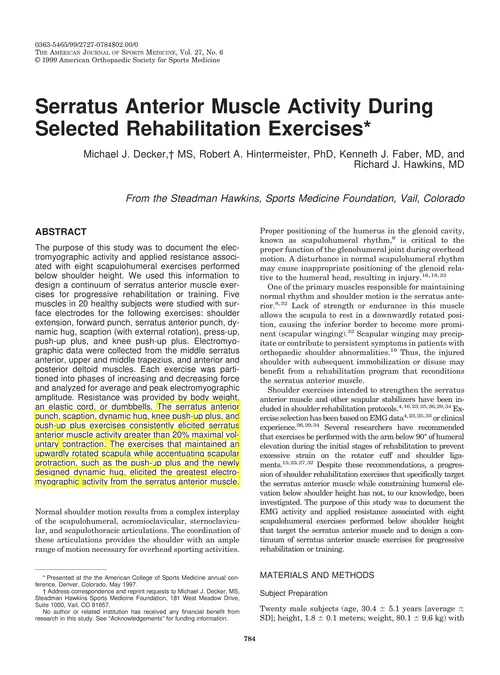
Serratus Anterior Muscle Activity During - Scott J. Sevinsky MSPT
For the wall slide and scapular plane shoulder elevation exercises, wall slide exercise would activate the serratus anterior.
adsPart of the document
Serratus Anterior Muscle Activity During
Selected Rehabilitation Exercises*
Michael J. Decker,² MS, Robert A. Hintermeister, PhD, Kenneth J. Faber, MD, andRichard J. Hawkins, MD
From the Steadman Hawkins, Sports Medicine Foundation, Vail, Colorado
ABSTRACT
The purpose of this study was to document the elec-
tromyographic activity and applied resistance associ-
ated with eight scapulohumeral exercises performed
below shoulder height. We used this information to
design a continuum of serratus anterior muscle exer-
cises for progressive rehabilitation or training. Five
muscles in 20 healthy subjects were studied with sur-
face electrodes for the following exercises: shoulder
extension, forward punch, serratus anterior punch, dy-
namic hug, scaption (with external rotation), press-up,
push-up plus, and knee push-up plus. Electromyo-
graphic data were collected from the middle serratus
anterior, upper and middle trapezius, and anterior and
posterior deltoid muscles. Each exercise was parti-
tioned into phases of increasing and decreasing force
and analyzed for average and peak electromyographic
amplitude. Resistance was provided by body weight,
an elastic cord, or dumbbells. The serratus anterior
punch, scaption, dynamic hug, knee push-up plus, and
push-up plus exercises consistently elicited serratus
anterior muscle activity greater than 20% maximal vol-
untary contraction. The exercises that maintained an
upwardly rotated scapula while accentuating scapular
protraction, such as the push-up plus and the newly
designed dynamic hug, elicited the greatest electro-
myographic activity from the serratus anterior muscle.
Normal shoulder motion results from a complex interplay
of the scapulohumeral, acromioclavicular, sternoclavicu-
lar, and scapulothoracic articulations. The coordination of
these articulations provides the shoulder with an ample
range of motion necessary for overhead sporting activities.Proper positioning of the humerus in the glenoid cavity,
known as scapulohumeral rhythm,


